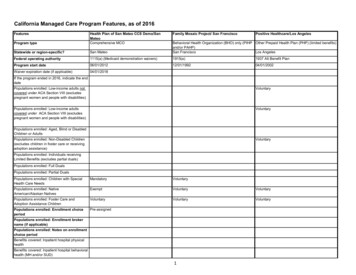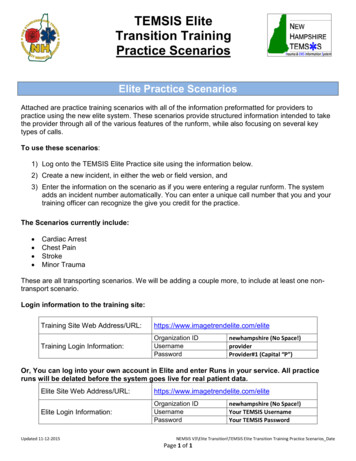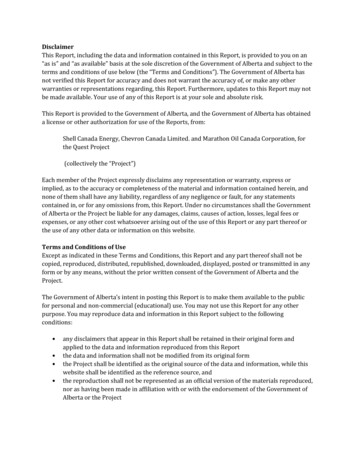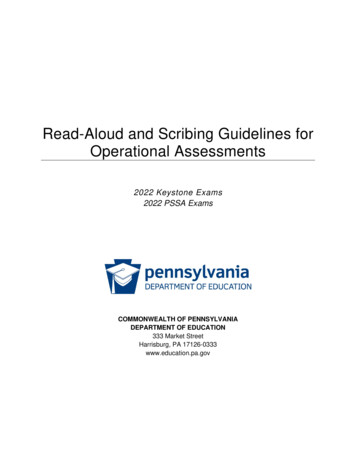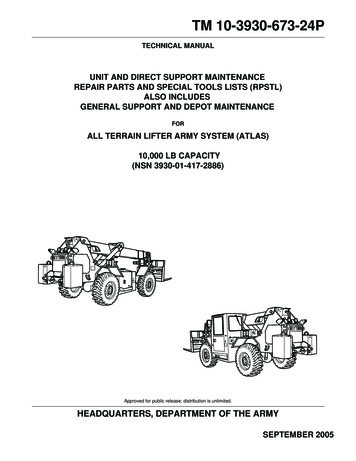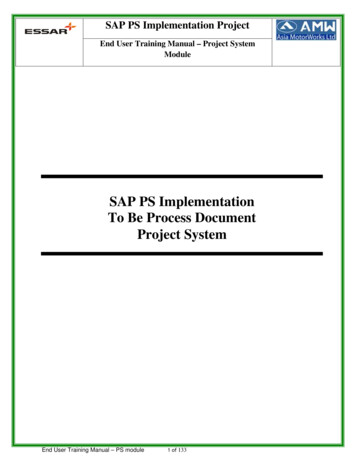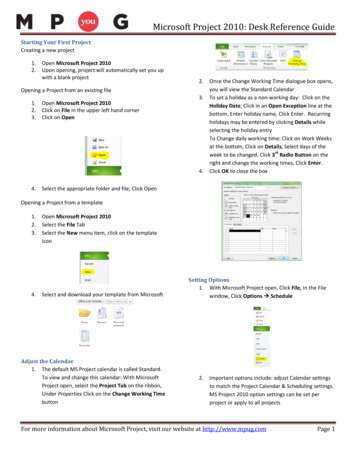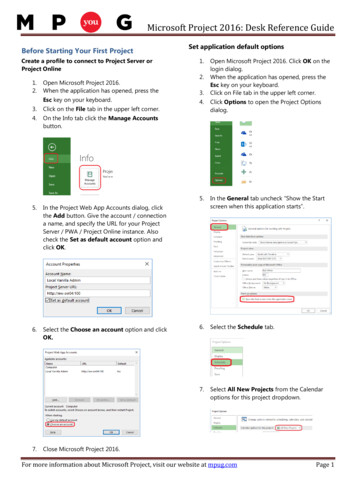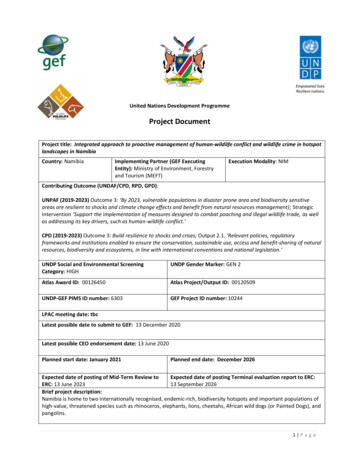
Transcription
United Nations Development ProgrammeProject DocumentProject title: Integrated approach to proactive management of human-wildlife conflict and wildlife crime in hotspotlandscapes in NamibiaCountry: NamibiaImplementing Partner (GEF ExecutingEntity): Ministry of Environment, Forestryand Tourism (MEFT)Execution Modality: NIMContributing Outcome (UNDAF/CPD, RPD, GPD):UNPAF (2019-2023) Outcome 3: ‘By 2023, vulnerable populations in disaster prone area and biodiversity sensitiveareas are resilient to shocks and climate change effects and benefit from natural resources management); StrategicIntervention ‘Support the implementation of measures designed to combat poaching and illegal wildlife trade, as wellas addressing its key drivers, such as human-wildlife conflict.’CPD (2019-2023) Outcome 3: Build resilience to shocks and crises; Output 2.1. ‘Relevant policies, regulatoryframeworks and institutions enabled to ensure the conservation, sustainable use, access and benefit-sharing of naturalresources, biodiversity and ecosystems, in line with international conventions and national legislation.’UNDP Social and Environmental ScreeningCategory: HIGHUNDP Gender Marker: GEN 2Atlas Award ID: 00126450Atlas Project/Output ID: 00120509UNDP-GEF PIMS ID number: 6303GEF Project ID number: 10244LPAC meeting date: tbcLatest possible date to submit to GEF: 13 December 2020Latest possible CEO endorsement date: 13 June 2020Planned start date: January 2021Planned end date: December 2026Expected date of posting of Mid-Term Review toExpected date of posting Terminal evaluation report to ERC:ERC: 13 June 202313 September 2026Brief project description:Namibia is home to two internationally recognised, endemic-rich, biodiversity hotspots and important populations ofhigh-value, threatened species such as rhinoceros, elephants, lions, cheetahs, African wild dogs (or Painted Dogs), andpangolins.1 P a g e
This globally significant biodiversity faces critical threats to its survival, key among these being:(i)escalating Human-Wildlife Conflict (HWC) - especially involving elephants, feline predators, crocodilesand hippopotamus (through damage to crops and infrastructure, loss of life or injuries to people andlivestock mortalities) – creating a strong disincentive among affected people to conserve wild animals;and(ii)the persistent threat posed by wildlife crime (WC) – notably poaching, through organized crimesyndicates and incidental illegal killing for subsistence purposes or retaliation resulting from HWC - topopulations of high value species, such as elephants, rhinoceros, and pangolins.The viability of the entire conservation effort in Namibia has also been challenged by the far-reaching and cascadingimpacts of global and national measures to respond to the COVID-19 pandemic, which first emerged in Namibia inMarch 2020. Global and national travel restrictions, and other disease-containment and mitigation measures, as wellas health risks posed by the disease itself, have brought the ecotourism sector to a standstill and has affected theability of wildlife management authorities to carry out core operations (including their ability to effectively addressboth human-wildlife conflict and wildlife crime). It has also caused major disruption to the country’s flagshipCommunity-Based Natural Resource Management (CBNRM) programme, which is critical in providing protection tosignificant wildlife populations over large areas of the country through community conservancies. These rely heavilyon tourism and conservation hunting to fund their conservation functions, provide jobs and support the broadersocio-economic development of rural communities.This Child Project under the World Bank-led Global Wildlife Programme (GWP) aims to safeguard wildlife byincentivizing conservation through proactive management of human-wildlife conflict and wildlife crime, and deliveryof wildlife-based benefits to rural communities in selected hotspot landscapes. To achieve this, it will adopt fourcomplementary approaches to collectively address the twin challenges of HWC and WC in communal Conservanciesand National Parks across three HWC/WC hotspot landscapes in Namibia: North Central (incorporating the flagshipEtosha National Park); North West (or Kunene); and North East (incorporating the Bwabwata-Mudumu National Parkcomplex, and falling partially within the KAZA Transfrontier Conservation Area).The first approach is centred on reducing, mitigating and preventing human wildlife conflict (HWC). The project willfocus on rebuilding and strengthening the capacities of conservancies, communal farmers, and government agenciesto more effectively plan for, manage and monitor HWC.The second approach is centred on combating wildlife crime (WC) and protecting wildlife populations. The project willfocus on strengthening the capacities of anti-poaching units, and for science-based management and monitoring ofpopulations of high-risk/high-value species.The third approach is centred on generating economic benefits for communities from wildlife-related enterprises. Theproject will focus on supporting the development and operationalisation of wildlife-based Joint Venture (JV)enterprises in community conservancies, strengthening the capacities of local communities to support, service andobtain employment in these JVs, and diversifying income streams in community conservancies to help offset the‘costs’ of living with wildlife. Under this approach, the project will contribute directly to rebuilding the communityconservancy sector in the wake of the COVID-19 pandemic and strengthening its resilience to possible future shocksand disturbances.The fourth approach is centred on enhancing local and national coordination, cooperation and knowledge sharing inHWC and WC. The project will focus on helping to build an HWC-WC community of practice at the local, national andregional geographic scales.The project outputs and activities are thus directed at: Improving co-existence between wildlife and rural communities (measured through a reduction in numberand impact of HWC incidents) in the hotspot landscapes. Ensuring that critical populations of high-value wildlife in the hotspot landscapes are effectively managed toreduce threats to their survival (measured through a decrease in poaching incidents and stable or growing2 P a g e
populations).Increasing the scale and extent of benefits flowing to affected communities from wildlife-based enterprises(measured through an increase in household income). Improving capacity for well-coordinated, knowledge-based management of HWC and WC among multiplestakeholders.As a result of these outcomes, it is envisaged that the net benefits to communities and landowners of living withwildlife would ultimately provide enough incentive for them to support its ongoing conservation, and populations ofhigh-risk, high-value and HWC-implicated species will be safeguarded over the longer term. (1) FINANCING PLANGEF Trust FundUNDP TRAC resourcesConfirmed cash co-financing to be administered byUNDP(1) Total Budget administered by UNDP(2) CONFIRMED CO-FINANCINGKfW Development BankUSD 6,247,018USD 0USD 0USD 6,247,018USD 11,715,629Government of Namibia (Ministry of Environment,USD 41,711,000Forestry and Tourism/Ministry of Finance)UNDPUSD 100,000(3) Total confirmed co-financing USD 53,526,629(4) Grand-Total Project Financing (1) (2) USD 59,773,647SIGNATURESSignature:Agreed by GovernmentDevelopmentCoordination AuthoritySignature:Agreed by Ministry ofEnvironment, Forestryand Tourism (MEFT)Signature:Agreed by r:Key GEF Project Cycle Milestones:Project document signature: within 25 days of GEF CEO endorsementFirst disbursement date: within 40 days of GEF CEO endorsementInception workshop date: within 60 days of GEF CEO endorsementOperational closure: within 3 months of posting of TE to UNDP ERCFinancial closure: within 6 months of operational closure3 P a g e
I.TABLE OF CONTENTSI.Table of Contents . 4II.Development Challenge . 7III.Strategy . 12IV.Results and Partnerships. 20V.Project Results Framework . 45VI.Monitoring and Evaluation (M&E) Plan . 49VII. Governance and Management Arrangements . 52VIII. Financial Planning and Management . 57IX.Total Budget and Work Plan . 59X.Legal Context . 69XI.Risk Management . 70XII. Mandatory Annexes . 73Annex 0: GEF Budget Template . 74Annex 1: Project maps and geospatial coordinates of project sites . 75Annex 2: Multi Year Work Plan . 78Annex 3: Monitoring Plan. 84Annex 4: Social and Environmental Screening Procedure (SESP) . 91Annex 5: UNDP Risk Register . 98Annex 6: Overview of Technical Consultancies . 103Annex 7: Stakeholder Engagement Plan . 114Annex 8: Environmental and Social Management Framework (ESMF) . 114Annex 9: Gender Analysis and Gender Action Plan . 114Annex 10: GEF Focal Area Tracking Tools . 114Annex 11: Letters of Co-financing Commitment . 114Annex 12: UNDP Partner Capacity Assessment (12.1 HACT and 12.2 PCAT) . 114Annex 13: UNDP Project Quality Assurance (PQA) Report . 114Annex 14: COVID-19 Risk/Opportunity Analysis and Action Framework . 114Annex 15: Climate Risk Assessment . 114Annex 16: GEF Core Indicator Worksheet . 114Annex 17: GEF Taxonomy Sheet. 114Annex 18: Indicative procurement Plan . 114LIST OF TABLES, FIGURES AND MAPSTable 1: Alignment between project outputs and delivery of GWP II outcomes . 15Figure 1: Project Theory of Change (TOC) diagram . 19Table 2: Partner baseline activities and initiatives . 31Table 3: Summary of overall project risks . 34Table 4: Summary of environmental and social safeguard risks . 37Table 5: Principles guiding stakeholder engagement during project implementation . 40Table 6: Summary of mechanisms to facilitate stakeholder involvement and participation . 40Table 7: Project Monitoring and Evaluation Plan and Budget . 51Table 8: Profile of the project stakeholders and target groups . 52Figure 1: Theory of Change . .19Figure 2: Project organization structure . 554 P a g e
ACRONYMS AND ABBREVIATIONSBNPBwabwata National ParkCBNRMCommunity Based Natural Resource ManagementCBOCommunity-Based OrganizationCCFCheetah Conservation FundCCFNCommunity Conservation Fund of NamibiaCOVID-19Coronavirus Disease 2019, the disease caused by the novel coronavirus, SARS-CoV-2CUHWCCoordination Unit for HWC (in the DWNP)CWCP(USAID-funded) Combatting Wildlife Crime ProjectDLTDesert Lion TrustDLPDesert Lion ProjectDWNPDirectorate of Wildlife and National ParksEHRAElephant Human Relations AidEIF(Namibia) Environmental Investment FundENPEtosha National ParkERC(UNDP) Evaluation Resource CenterESMFEnvironmental and Social Management FrameworkFC(Project) Field CoordinatorFM(Project) Financial ManagerGEFGlobal Environment FundGIZDeutsche Gesellschaft fur Internationale ZusammenarbeitGPTFGame Products Trust FundGWPGlobal Wildlife ProgrammeHECHuman Elephant ConflictHPCHuman Predator ConflictHWCHuman Wildlife ConflictHWCSRSHuman Wildlife Conflict Self Reliance SchemeICCWCInternational Consortium for Combating Wildlife CrimeIRDNCIntegrated Rural Development and Nature ConservationIWPPIntegrated Wildlife Protection ProgrammeIWTIllegal Wildlife TradeJVJoint VentureKAZA TFCAKavango-Zambezi Trans-frontier Conservation AreaLACLegal Assistance CentreM&EMonitoring and EvaluationMEFTMinistry of Environment, Forestry and TourismMETTManagement Effectiveness Tracking ToolMTR(Project) Mid-Term ReviewNACSONamibian Association of CBNRM Support OrganisationsNAMPARKSNamibia National Parks ProgrammeNBTNature-Based Tourism5 P a g e
NDTNamibia Development TrustNGONon-Government OrganizationNNFNamibia Nature FoundationNPNational ParkNPDNational Project DirectorPAProtected Area/ Project AssistantPBProject Board (alternatively termed ‘Project Steering Committee’)PIRProject Implementation ReviewPMProject ManagerPMUProject Management UnitPRFProject Results FrameworkSBAAStandard Basic Assistance AgreementSESP(UNDP) Social and Environmental Screening ProcedureSESO(Project) Social and Environmental Safeguards OfficerSRTSave-the-Rhino TrustTATraditional AuthorityTE(Project) Terminal EvaluationTOCTheory of ChangeTOSCOTourism Supporting Conservation TrustUNODCUN Office for Drugs and CrimeUSAIDUnited States Agency for International DevelopmentWBWorld BankWCWildlife CrimeWCM(Project) Wildlife Conservation ManagerWCPWildlife Credits ProgramWWFWorld Wide Fund for Nature6 P a g e
II.DEVELOPMENT CHALLENGEProject context:1.Namibia hosts remarkable species diversity and exhibits high levels of endemism (see below). The country hasthe world’s largest population of cheetah, is home to 34% of the largest-remaining free-ranging black rhinopopulation in the world, has unique desert-dwelling populations of rhino, lion and elephants, and also hostsother high-value, threatened species such as painted dog (formerly called African wild dogs) and pangolin. Thecountry incorporates two globally-designated ‘biodiversity hotspots’ – the Sperrgebiet (in the Succulent KarooBiome) and the Namib escarpment zone – and four Ramsar Wetland Sites of International Importance.Type of organismNumber of species% 24628insects100,000 24arachnids82111% of spiders, 47% of scorpions, 5% of solifugids2.To safeguard this unique biodiversity, the Government of Namibia, working with a diversity of partners, hasestablished an impressive network of 20 state-owned protected areas, covering some 17% of the country’sland surface (approx. 140,394 km2) and the entire 1,500 km of its coastline. These state protected areas aresupplemented by a strong community-based natural resource management (CBNRM) programme, which isdelivered through 86 registered communal conservancies1 (that allow for mixed conservation and productionland uses) and 32 registered community forests, covering around 20% of the country’s land surface (approx.166,267 km2), along with a smaller number of freehold conservancies, private game reserves, tourismconcessions and community fish reserves.3.Since independence, Namibia’s flagship community-based conservancy program has been a key contributor toenvironmental conservation and economic development in rural areas. The CBNRM programme devolvesrights to community-led institutions to manage, use and benefit from natural resources and wildlife. This isachieved largely through involvement of communities in activities such as conservation hunting and ecotourism, including through a legislated Joint-Venture enterprise scheme involving government agencies,national non-governmental organizations, private sector investors and rural communities. Through wages andsalaries, these businesses provide the greatest source of cash income to households in communityconservancies2. The conservancy system also provides a legislated basis for communities to benefit fromconsumptive use of wildlife through subsistence-based and commercial hunting (through concessions), andmeasures to compensate for damage caused by wildlife. In 2017, community-based conservation created 5,350jobs and generated more than 9 million (approx. N 114 million) in returns for local communities. To date,hunting has been the most direct way for local communities to extract value from wildlife3, with about 40% ofconservancy income derived from this.1Communal conservancies are self-governing, democratic entities, run by their members, with fixed boundaries that are agreedwith adjacent conservancies, communities, or landowners. Communal conservancies are obliged to have wildlife managementplans, to conduct annual general meetings, and to prepare financial reports. They are managed under committees elected bytheir members. Conservancies are recognised by the MEFT, but not governed by the Ministry, although MEFT has powers to deregister a conservancy if it fails to comply with conservation regulations.2 MET/NACSO (2018). State of Community Conservation in Namibia - A Review of Communal Conservancies, Community Forestsand other CBNRM Activities (Annual Report, 2017, MET/NACSO), in Lendelvo, Pinto and Sullivan (2020). Namibian Journal ofEnvironment 4B: 1 - 153 Cooney,R; Freese,C; Dublin,H; Roe,D; Mallon,D; Knight,M.(2017). The baby and the bathwater: trophy hunting, conservation7 P a g e
4.Wild animals and unique natural landscapes are the primary drawcard for the large number of tourists whousually visit Namibia annually, driving a multi-million-dollar tourism sector – before the COVID-19 pandemicthis was the third largest economic sector in the country, contributing more than 11% of GDP. Nature-basedtourism in national parks and community conservancies has provided many jobs and stimulated economicdevelopment, with the potential to deliver benefits to an even larger number of people. Currently, there are 38conservancies directly involved in tourism activities, including through 61 joint venture lodges and campsitesemploying 1,175 full-time and 50 part-time staff.4 In 2019, these Joint-Venture tourism enterprises accountedfor 64% of cash income and in-kind benefits to communities, and in some conservancies tourism has becomethe key source of income (replacing trophy hunting)5.5.Communities in conservancies are directly engaged in a diversity of livelihoods associated with tourismactivities, including craft production, running camp sites, guesthouses/B&Bs, cultural villages, joint venturelodges, hunting and tour guiding – in 2017, 62 conservancies hosted 171 natural resource-based enterprises.There are a further 15 nature-based tourism concessions6 on state owned land: one for hunting, 11 for touristlodges, and 3 for activities such as hot-air ballooning.6.Although tourism and hunting provide important income diversification opportunities for rural communities, ithas been estimated that the general effect of the COVID-19 pandemic will cause losses of N 55.3 million inannual tourism revenue in Namibia and N 60.4 million in salaries of staff living in conservancies7. Farming(mainly livestock-keeping) is still the main source of livelihoods for most conservancy members, but its viabilityis being impacted by the growing effects of climate change (see Annex 15 for a full account), and increasinghuman-wildlife conflicts. Access to alternative, nature-based income streams for communities and farmers isthus becoming increasingly important, and measures are needed to bolster the resilience of tourism-relatedlivelihoods and the broader conservancy economy8.7.Clearly, natural resources and wildlife occupy an integral position in the lives of Namibia’s rural population,supporting cultural value systems and providing the raw materials for meeting daily subsistence and livelihoodneeds. This means that the conservation and sustainable use of Namibia’s biodiversity, and the fair andequitable sharing of benefits arising from this, is inextricably linked – wildlife will only be conserved if the netbenefits to communities and landowners of living with wildlife, or engaging in its conservation, outweigh thenet costs.Alignment with national priorities:8.The country’s fifth National Development Plan (NDP5) and second National Biodiversity Strategy and ActionPlan both give priority to sustainable use of biodiversity as one of the key drivers of poverty alleviation andequitable economic growth.9.Namibia’s Second National Biodiversity Strategy and Action Plan 2013-2022 (NBSAP) details the nationalstrategies and programmes for the conservation and sustainable use of biological diversity under theConvention on Biological Diversity (CBD).and rural livelihoods. Unasylva 249(68): 3-164 MET/NACSO (2020), in Lendelvo et al., 2020. Note: figures exclude employment provided through hunting concessions.5 Not all conservancies have the potential to earn strong incomes from trophy hunting or tourism. Many are on marginal landwith little wildlife, but still have a strong conservation value to Namibia.6 Concession means the right, whether full or restricted or shared or exclusive to conduct tourism activities and/or tocommercially use of state-owned plant and/or animal resources (collectively referred to as wildlife resources) on businessprinciples in proclaimed protected areas and any other State Land for a specified period of time. There are four broad types ofconcession: lodge-based tourism, camp site-based tourism, trophy hunting, and traversing rights (whereby a communalconservancy or tour operator may have rights to traverse national park areas with tourist clients). The nature-based tourismconcessions granted to conservancies are called ‘head concessions’ and are conditional upon conservancies tendering outmanagement of tourism in concession areas to private sector operators with both experience and capacity.7 Paxton, M.(2020). The coronavirus threat to wildlife tourism and ourism-and-conservation.html8 At the time of writing this Prodoc, the Ministry of Forestry and Tourism of Namibia is commissioning the development of aTourism Recovery Strategy to identify measures to mitigate the impacts of COVID-19 on tourism-based livelihoods8 P a g e
10. Namibia has adopted numerous policies, legal instruments, and strategies for addressing HWC and WC andenabling communities and private businesses to benefit from wildlife-based tourism and sustainable naturalresource management. These include: (i) the Nature Conservation Ordinance (1975) as amended by the NatureConservation Amendment Act (1996); (ii) the National Strategy on Wildlife Protection and Law Enforcement(2016); (iii) the Revised National Policy on Human Wildlife Conflict Management (2018-2027), and itsassociated Measures and Guidelines for Implementation of the Revised National Policy on Human WildlifeConflict Management (2018); (iv) the National Policy on Community-Based Natural Resource Management(2013); (v) the National Policy on Protected Areas’ Neighbours and Resident Communities (2014); (vi) theNational Policy on Tourism and Wildlife Concessions on State Land (2007); (vii) the draft Wildlife and ProtectedAreas Management Bill (2019); (viii) the draft National Strategy on Wildlife Protection and Action Plan (inprep.); (ix) the Controlled Wildlife Products and Trade Act (2008); the Forest Act (2001); and the ProtectedAreas and Wildlife Management Bill (in process). Provisions for Environmental Impact Assessments (EIAs) fallunder the Environmental Management Act (2007).11. These national-level policies, legal instruments and strategies are in turn supported by a hierarchy of actionplans and programmes at regional and local levels, with a diversity of institutions in government and civilsociety mandated to facilitate their implementation.12. The administration of communal land is primarily governed by the Communal Land Reform Act (2002), theNational Resettlement Policy (2001) and the Traditional Authorities Act (2000). The draft White Paper on theRights of Indigenous Peoples in Namibia (2019) further attempts to address issues faced by indigenous peoplesin Namibia. The Environmental and Social Management Framework (ESMF) appended to this Prodoc as Annex8 and the Indigenous Peoples Planning Framework that it contains, provides a more comprehensive overviewof the enabling legislative and policy framework applicable to communal land and indigenous peoples.13. Namibia’s National Gender Policy (2010 – 2020) provides the broad enabling framework for all sectors tomainstream gender in line with priorities set in the NDP5. The enabling legal and policy framework for genderequity and empowerment of women in Namibia is further detailed in the Gender Analysis and Gender ActionPlan in Annex 9.14. Namibia is party to several treaties, conventions and other multilateral agreements, including: Convention onBiological Diversity (CBD) and Nagoya Protocol; Convention on the International Trade in Endangered Speciesof Wild Flora and Fauna (CITES); UN Framework Convention on Climate Change (UNFCCC); UN Convention toCombat Desertification (UNCCD); Convention for the Protection of World Cultural and Natural Heritage;International Convention on the Elimination of All Forms of Racial Discrimination (ICERD); InternationalCovenant on Economic, Social and Cultural Rights (ICESCR); International Covenant on Civil and Political Rights(ICCPR); Convention on the Elimination of all Forms of Discrimination Against Women (CEDAW); and UnitedNations Declaration on the Rights of Indigenous Peoples (UNDRIP). Additionally, Namibia takes part in variousinternational standards, reviews and processes including: United Nations Sustainable Development Goals(SDGs); African Charter on Human and Peoples' Rights (ACHPR); and Universal Periodic Review (UPR).Problems and root causes:15. Many Namibian conservancies are reporting increased abundance of wildlife populations, but this is now beingaccompanied by increased frequency (8,067 incidences 2017) and severity of Human Wildlife Conflict (HWC) especially involving elephants, feline predators, crocodiles and hippopotamus - resulting in damage to crops,gardens and infrastructure (water points, fences, kraals, boreholes, etc.), loss of life or injuries to people andlivestock mortalities. Most livestock predation incidences arise from livestock and grazing managementpractices that leave livestock vulnerable to predators (including hyena, cheetah, jackal, leopard, lion andcrocodile). The expansion of predator and elephant home ranges deep into human settlements, and expansionof human settlements into predator and elephant movement c
high-risk, high-value and HWC-implicated species will be safeguarded over the longer term. (1) FINANCING PLAN GEF Trust Fund USD 6,247,018 UNDP TRAC resources USD 0 Confirmed cash co-financing to be administered by UNDP USD 0 (1) Total Budget administered by UNDP USD 6,247,018 (2) CONFIRMED CO-FINANCING KfW Development Bank USD 11,715,629
